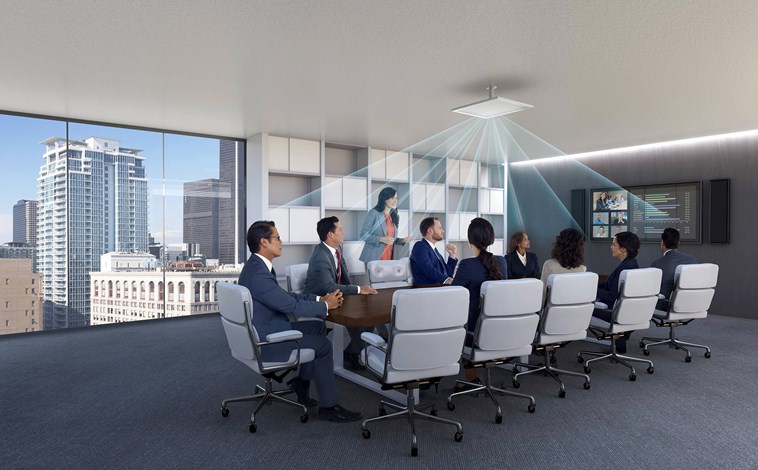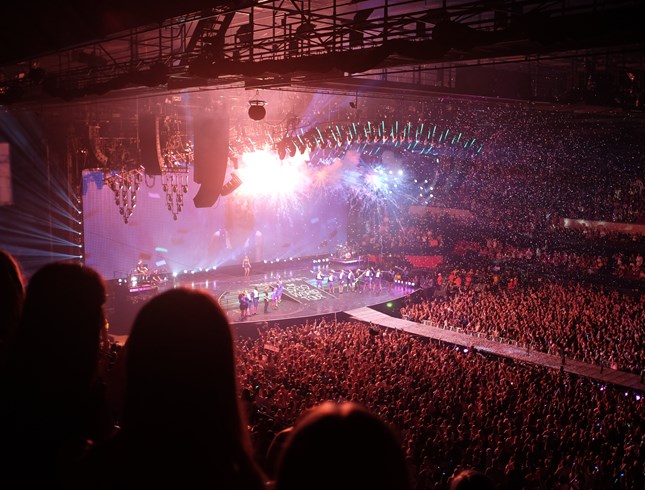
Image: Conference room with a ceiling mounted microphone array (Source: Shure)
We previously published a design guide of important acoustic considerations when designing video conferencing facilities. Now you’ve got the framework of how to make your space sound great, what do you need to consider to make it function seamlessly? Whether you are setting up a home office or a high-end corporate boardroom, our design team has the following 6 key technical aspects for you to keep in mind.
1. Physical Layout
Positioning. Careful consideration of the screen, camera and microphone positioning can have a big impact on speech intelligibility and visual acuity. This is particularly true if the room is in the traditional rectangular boardroom configuration where team members can be either too close or far away from VC equipment.
2. Cable Infrastructure
Check the available broadband. It’s important to check the actual available versus advertised bandwidth for any video conferencing project. Is the cabling just copper or is fibre available? In certain locations, leased lines may be considered due to bandwidth limitations being imposed during peak hours.
Is your cable infrastructure futureproofed? Just as important, especially for bigger offices, is to ensure the internal cable infrastructure, such as network cables and switches, has been designed to accommodate future increases in bandwidth demand.
3. Lighting
Can the camera see everyone in the room clearly? While there are many technical considerations that are outside the scope of this article, there are a couple of simple factors can vastly improve the video image.
- Lighting source - Where possible, avoid down light type fixtures and go for soft diffused lighting that will flood the room in an even soft light. It is important to ensure all light sources are the same type and have a similar colour rendition.
- Lighting levels - Lighting levels should be bright enough for participants to be able to read comfortably from notes on the table.
4. Power
Do you have dedicated VC only electrical circuits? Ensuring a dedicated and ‘clean’ power supply will increase the sound and image quality. Run VC devices off one circuit from the electrical mains board to the conference room, ensuring that the power line is not shared with other equipment such as elevators, or vacuum cleaners.
5. Video: Display & Camera
Ideal display size is calculated by the nearest & furthest viewer distance. It is generally accepted that the nearest viewer should not be seated closer than the width of the screen. Calculating the ideal screen size for the furthest viewer can be more complicated, however, as a guide, a 55” display monitor will be adequate for general display of 24 point size text to a distance of 4 metres. A larger display or secondary display monitor on the table may be required for larger conference rooms.
Positioning the screen and video camera. Locating the bottom of the screen at eye level will ensure optimum viewing for all participants in the room. To ensure that all participants can be seen from the camera’s point of view, most cameras are mounted on the top or bottom of a single display, or in between the two displays.
Selecting the right camera. Depending on your needs and budget, the camera can be a simple static type camera or a pan-tilt-zoom (PTZ) type camera. Today, most HD cameras have HD resolution and are available from wide angle up to 12 x zoom capability, allowing for high quality images to be transmitted.
6. Audio: Sound System & Microphones
Microphone and loudspeaker placement are important factors in maximising speech intelligibility. Getting elements of your set-up right will reduce electronic feedback and acoustic cancellation issues.
Position loudspeakers at the front. If you are setting up a small-medium sized space, in most cases you will want to install your loudspeakers at the front of the room, next to the display monitors. For larger rooms, the front loudspeakers may need to be supported with ceiling loudspeakers at the rear of the room.
Multiple microphone placement options. Microphones can be mounted in front of the video display monitor, on the table top, or on the ceiling. If the conference room has a capacity of more than 5 or 6 participants, there is usually a requirement for more than one microphone. There are also microphone arrays that offer automatic speech detection. These work by electronically sensing and steering the microphone pickup pattern towards the person speaking and can be mounted in between two video display monitors.
Omnidirectional or multidirectional microphone? Most microphones are omnidirectional, which means they pick up sound from all around their surroundings, including ambient sounds in the room such as the air-conditioning fan, tapping of computer keyboards or rustling of paper. For better results, intelligent multidirectional microphone arrays can be used. These are able to detect and steer the microphone’s pickup beam towards the direction of the speaker, using digital signal processing that incorporate automatic mixing, equalisation and echo reduction.
7. Conclusion
Following these six steps, in combination with our acoustic design guide for VC, will ensure that your next video conferencing system is both functional and futureproofed:
- Physical Layout
- Cable Infrastructure
- Lighting
- Power
- Video
- Audio
Contact Us
If you require design advice for an AV or sound system project, please contact our AV and sound system design specialist, Kheong Sen Lim.
